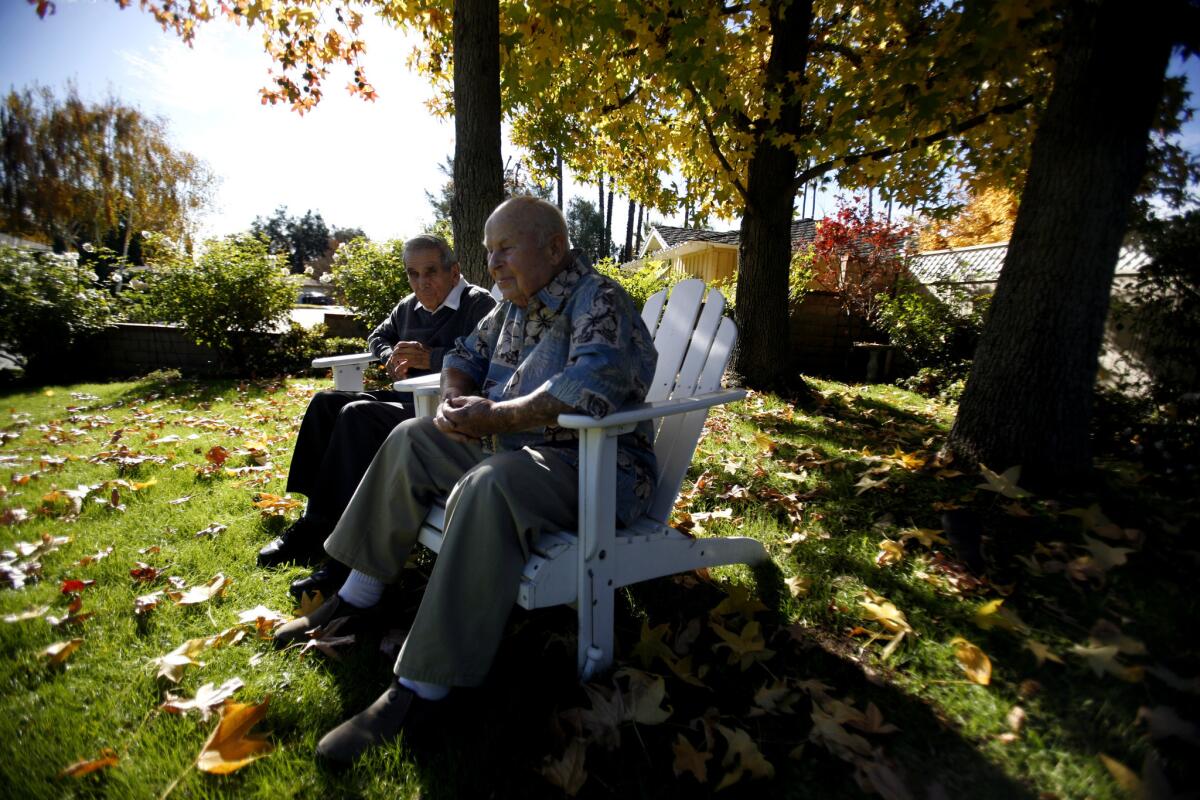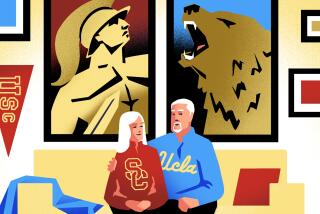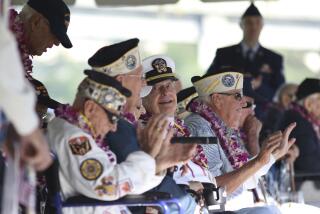From there to fraternity

They were barely men at the time, unaware of each other but baptized by the same fire.
Paul Perrault was 21, a naval officer aboard the light cruiser Phoenix, anchored in Pearl Harbor’s East Loch. He had just risen from his bunk when cannon-like blasts tore through the morning calm. Scrambling to his post in the gunnery, he saw a sky speckled with Japanese planes.
Across the harbor on Ford Island was Seaman 2nd Class Anthony “George” Mark, 18, who narrowly escaped as a plane strafed his area and bombs plunged into nearby hangars.
Twenty years later, two fathers met on a Monrovia cul-de-sac. One lived in a tan-colored home with his wife and two children. The other was moving his family of five into the house next door. After a month of small talk, the men learned of their shared past.
Chance had saved their lives. Chance made them neighbors.
::
A bond formed naturally between two men who shied from recognition.
“I wasn’t impressed that George was at Pearl Harbor and George wasn’t impressed that I was,” Perrault said.
Instead they talked football, went to Dodgers games, rooted for UCLA and grabbed seats together at local high school games. Once, an acquaintance gave them tickets to the Super Bowl, held that year in Pasadena. Their excitement at sitting on the 50-yard line would become a running joke after their view was obstructed by players standing on the sideline.
On quiet Parkrose Avenue in Monrovia, they were separated by a carport, a lemon tree and the breezes that swept in between. Mark and his wife, Dorothy, arrived in 1960 with their son and two daughters. By then, Perrault had lived there 10 years with his wife, Orla, and their two children.
Mark beat a regular path to Perrault’s stoop, and they grew comfortable in each other’s backyards. They went on a trip to Las Vegas, where they casino-hopped and took in a couple of glitzy shows. They watched each other marry off children, grow gray, lose family members and battle illness.
Perrault was the introverted one, a history buff with a gentle demeanor who was likely to be found gardening or reading.
“I used to send the girls over to his house,” Mark said. “They’d ask me something about school. I’d say, ‘Go next door and talk to Paul.’ He’s sharp.”
Mark preferred fishing and camping. He was animated around strangers and had a hearty laugh. An electrician, he would install Perrault’s appliances and fix wiring for free.
Tucked inside their houses were medals, certificates, black-and-white photos. But they hardly spoke of the history they shared, seeing little need to compare notes outside of their mutual disdain for the mass internment of Japanese Americans after Pearl Harbor. The anniversary of the attack was rarely acknowledged, although Mark would sometimes wish Perrault a happy Pearl Harbor day.
Neither joined a veterans association until they were honored by one. They graciously accepted but never went to a meeting.
Mark, now 87, has returned to Oahu three times, finding more excitement in driving around the island than in attending dinners or dances where he would be among honored guests. Perrault, 90, has never been back.
The two belong to a dwindling fraternity. An estimated 4,000 Pearl Harbor survivors are still alive.
“It was just luck -- where you happened to be and how the Japanese planned to bomb,” Perrault said. “People say, ‘God was with you,’ but I think, ‘How about the 3,000 that died?’ How come God wasn’t with them?”
There is little to be proud of when it comes to surviving a war, Mark said. “We got out and we’re out, period.”
::
Mark grew up in L.A.’s El Sereno and Lincoln Heights neighborhoods, the son of Russian immigrants who ran a small grocery store. A teenager during the Great Depression, he sold newspapers, washed dishes and cleaned a butcher shop where he was paid in pork chops and lunchmeat.
He volunteered for the Navy at 17 and was trained to repair bombsights. His squadron arrived at Pearl Harbor in 1941, the day after Halloween.
Perrault had been in Hawaii since the summer. Raised in Monticello, Minn., a town that was all of six square miles, he joined the Navy after two years of college and found himself aboard the Phoenix with 900 men.
“Now that I look back on it, it was quite a shock,” Perrault said. “I thought I was kind of a big shot in town and when I got out, why, I was going to do big things. But nobody really knew me or cared.”
Oahu offered white sand, brilliant sunsets and a sense of safety. Days were spent patrolling peaceful waters, checking equipment and undergoing training. Perrault was at sea, in charge of the starboard aircraft gun. On land, Mark repaired and maintained bombsights and instructed others in their use.
Off-duty officers swam off the beach alongside Waikiki, played volleyball and went sightseeing. At night, the harbor twinkled with the deck lights of dozens of ships. On Dec. 6, 1941, Perrault attended a shipboard screening of the Bette Davis film “The Little Foxes.” He was eager to sleep in the next day.
::
The first boom came just before 8 a.m. Running outside the hangar, Mark was greeted by a fighter plane emblazoned with scarlet circles -- the unmistakable emblem of Imperial Japan, Land of the Rising Sun.
His heart hammered as he dodged gunfire and dashed back inside. Wave after wave of Japanese planes dropped torpedoes into suddenly roiling waters. When dive bombers attacked the battleship Nevada, Mark watched bodies hurtle through the air. A detonation at a nearby dock threw him into lockers. “Oh, my God, we’re at war,” he said.
He joined a group of mechanics pushing planes out of burning hangars, then climbed into a loft to fling metal barrels filled with gas masks to the ground.
About a mile away, Perrault sat high in the Phoenix, sickened by the panorama of fire and destruction.
A voice on the loudspeaker instructed the crew to man their battle stations. “This is not a drill!” someone barked.
Because his gun required coordinates and altitudes to operate and was not designed to target dive bombers, Perrault could do little but watch ships sink and smoke rise. Below him, the water was littered with death.
After three relentless hours, the enemy disappeared. Ford Island kicked into gear as officers cleaned and assembled machine guns, preparing for a reengagement that would never materialize. Over the next few days, equipment was salvaged, ashes were swept, bodies were gathered, losses were counted.
Perrault and Mark would later call it an incomprehensible experience, too chaotic to be terrifying.
::
A half-century has passed since their paths converged in Monrovia. Perrault was working in sales for a Pasadena laundry service. Mark was on the verge of starting his own electrical business in Los Angeles.
Now they spend most days at home, slowed by age and congestive heart failure. Perrault is legally blind, has a pacemaker and wears two hearing aids. Mark suffered a heart attack three years ago. They speak of the war only when asked and are quick to quash any illusions to bravery or heroism. They are survivors, they say, nothing more.
It was all a matter of chance--the same force that would lead them to modest homes that sit side by side on a quiet street.
--
More to Read
Start your day right
Sign up for Essential California for news, features and recommendations from the L.A. Times and beyond in your inbox six days a week.
You may occasionally receive promotional content from the Los Angeles Times.







